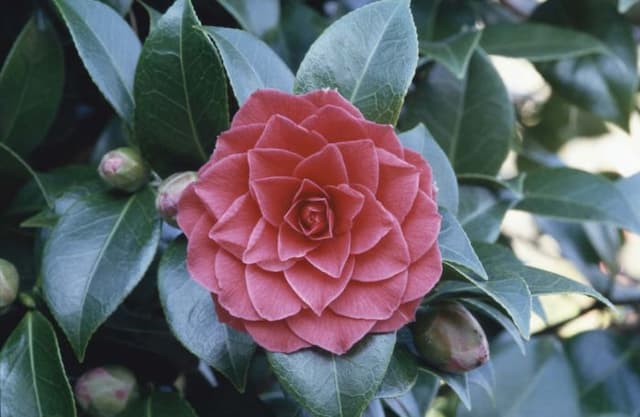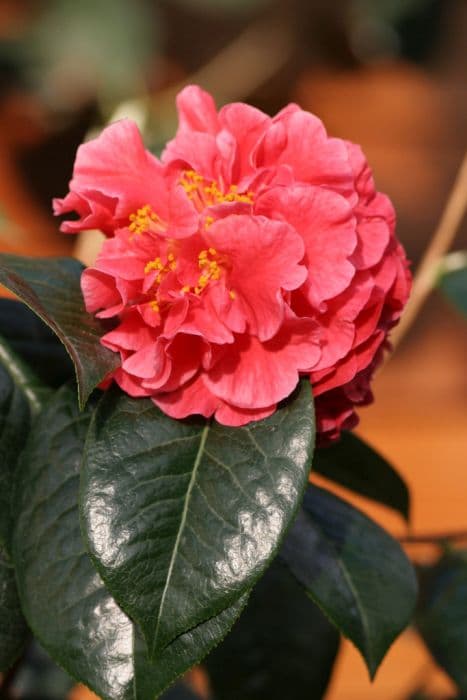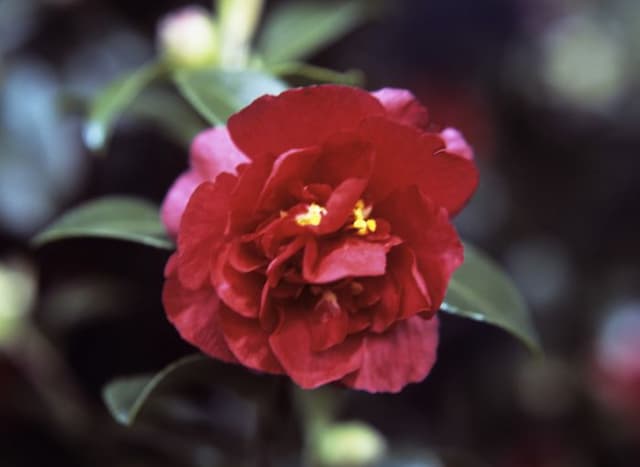Camellia Camellia × williamsii 'Joe Nuccio'

ABOUT
Camellia 'Joe Nuccio' is a visually striking ornamental plant that boasts glossy, deep green foliage. What sets this camellia apart is its splendid flowers that are a true spectacle when in full bloom. The bloom color is vibrant, often a rich pink with intricate, ruffled petals that can also exhibit a blend of softer pinkish hues. These flowers make for a stunning contrast against the shiny leaves, creating an eye-catching display in any garden setting. The blooms themselves are notably large and showy, commanding attention with their layered, peony-like form that adds an element of luxurious texture. The petals are arranged in such a way that they create a sense of fullness and depth, enhancing the overall opulence of the flower. During its blooming season, which generally falls in the cooler months, Camellia 'Joe Nuccio' becomes a focal point of beauty, drawing the eye and often becoming the centerpiece of a cultivated landscape. As an evergreen shrub, the plant maintains its lush foliage year-round, providing a constant backdrop of greenery that serves as a beautiful foil for other plants. While the leaves are fairly typical in shape, with a slightly serrated edge, their rich color and sheen contribute to the plant's elegant presentation. Overall, Camellia 'Joe Nuccio' adds a luxurious touch to gardens, with its delightful flowers that offer a wondrous display of color and form, accompanied by the perennial charm of its glossy leaves.
About this plant
 Names
NamesFamily
Theaceae
Synonyms
Joe Nuccio Camellia
Common names
Camellia × williamsii 'Joe Nuccio'.
 Toxicity
ToxicityTo humans
Camellia plants, including Camellia × williamsii 'Joe Nuccio', are generally not considered toxic to humans. They do not typically cause severe symptoms if ingested. However, as with any plant material, individual sensitivities can vary, and ingesting parts of the plant might cause mild gastrointestinal upset in some people, such as nausea or diarrhea.
To pets
Camellia plants, including Camellia × williamsii 'Joe Nuccio', are also generally not considered toxic to pets. They are not known to cause serious poisoning in animals such as cats and dogs. If a pet ingests parts of this plant, they may possibly experience mild gastrointestinal upset, including vomiting or diarrhea, depending on the amount consumed and the individual animal's sensitivity.
 Characteristics
CharacteristicsLife cycle
Perennials
Foliage type
Evergreen
Color of leaves
Green
Flower color
Pink
Height
6-10 feet (1.8-3 meters)
Spread
5-8 feet (1.5-2.4 meters)
Plant type
Shrub
Hardiness zones
7-9
Native area
East Asia
Benefits
 General Benefits
General Benefits- Aesthetic Appeal: Camellia 'Joe Nuccio' produces vibrant blooms that enhance the visual appeal of gardens and landscapes.
- Year-Round Interest: With its glossy evergreen leaves, the plant provides a consistent backdrop even when not in bloom.
- Low Maintenance: Once established, it requires minimal care, making it suitable for gardeners with limited time.
- Diverse Landscaping Use: It can be used for hedges, specimen planting, or container gardening, offering versatility in design.
- Shade Tolerance: It performs well in partial shade, which makes it adaptable to a variety of garden settings.
- Drought Resistance: The plant has good tolerance to dry conditions once fully established, requiring less frequent watering.
- Cold Tolerance: It's capable of withstanding cooler temperatures compared to other camellias, broadening its geographical planting range.
- Attracts Pollinators: The flowers provide nectar and attract bees and other pollinating insects, supporting local ecosystems.
- Long Blooming Season: The plant offers an extended blooming period from late winter to early spring, adding color during typically dull months.
- Privacy: When planted in a series, it can form a dense screen providing privacy and noise reduction.
- Soil Adaptability: It is tolerant of a range of soil types, although it prefers well-drained, acidic soils.
- Resistant to Pests: Camellia 'Joe Nuccio' has good resistance to common pests, reducing the need for chemical treatments.
 Medical Properties
Medical PropertiesThis plant is not used for medical purposes.
 Air-purifying Qualities
Air-purifying QualitiesThis plant is not specifically known for air purifying qualities.
 Other Uses
Other Uses- Culinary garnish: The flowers of the Camellia can be used to add a splash of color to salads or as an elegant garnish on plates for their aesthetic appeal.
- Photography subjects: Due to their vibrant colors and attractive form, Camellia flowers are popular among photographers looking to capture the beauty of nature.
- Artistic inspiration: Artists may use Camellias as subjects in paintings or drawings because of their varied and vivid colors and forms.
- Educational tool: Camellias can be used in schools or botanical studies to teach students about plant biology, hybridization, and horticulture.
- Special events decoration: The Camellia flowers are often used in floral arrangements for weddings, banquets, and other events.
- Bioindicator: Camellias can serve as bioindicators for gardeners, showing signs of soil conditions or air quality through their health and blooms.
- Fashion inspiration: The striking flowers of the Camellia may inspire fashion designers to create patterns or color palettes for their textiles.
- Crafting: The sturdy leaves and beautiful flowers can be used in making DIY crafts like wreaths, greeting cards, or pressed flower art.
- Natural dye source: The petals of the Camellia can be used to create natural dyes for fabrics, paper, or even in crafting.
- Collecting: Horticulturists and plant enthusiasts might cultivate Camellias as part of a rare plant collection for display and preservation.
Interesting Facts
 Feng Shui
Feng ShuiThe Camellia is not used in Feng Shui practice.
 Zodiac Sign Compitability
Zodiac Sign CompitabilityThe Camellia is not used in astrology practice.
 Plant Symbolism
Plant Symbolism- Adoration and Perfection: The camellia is often associated with adoration and perfection, making it a popular gift to express admiration.
- Longevity and Faithfulness: With its evergreen qualities, camellias symbolize the endurance of life and can represent long-lasting devotion in relationships.
- Desire or Passion: Its lush petals and rich colors are suggestive of deep desire or passion for someone.
- Refinement: Camellias are considered symbols of refinement and perfection due to their elegant form and pristine blossoms.
- Gratitude: Giving a camellia can express gratitude or a way to say 'thank you' because of its beauty and the joy it brings.
 Water
WaterWilliamsii camellias, like 'Joe Nuccio', prefer evenly moist soil, so water when the top inch of soil feels dry to the touch. This usually equates to watering every 7 to 10 days, but frequency can vary based on temperature and humidity. Use about 1 to 1.5 gallons of water per plant each time, ensuring the soil is moistened thoroughly but not waterlogged. During the growing season in spring and summer, they may require more frequent watering, especially if they are in pots or in warm, dry climates. Always avoid overhead watering to prevent leaf diseases and instead water at the base of the plant.
 Light
LightThe Williamsii camellia, specifically 'Joe Nuccio', thrives in partial shade where it can receive filtered sunlight. A spot that offers morning sun and afternoon shade is ideal to prevent leaf scorch and bud drop, common issues when exposed to intense midday sun. East or north-facing locations are usually the best spots for a Williamsii camellia in your garden.
 Temperature
TemperatureWilliamsii camellias, specifically 'Joe Nuccio', grow best in temperatures ranging between 60 and 75°F. They can withstand minimum temperatures down to around 20°F but should be protected from harsh winter winds. Optimal growth occurs when they are not subject to temperatures above 85°F for extended periods, as excessive heat can impair flowering and cause stress to the plant.
 Pruning
PruningPrune the Williamsii camellia 'Joe Nuccio' to maintain its shape, remove any dead or weak branches, and to encourage healthy growth. The best time to prune is right after the flowers fade in late winter to early spring before new growth starts. You typically won't need to prune more than once a year, and it's important to use clean, sharp pruning tools to make clean cuts.
 Cleaning
CleaningAs needed
 Soil
SoilCamellia × williamsii 'Joe Nuccio', commonly known as Camellia 'Joe Nuccio', thrives best in well-draining, acidic soil with a pH of 5.0 to 6.5. A mix of equal parts potting soil, peat moss, and perlite or pine bark can create an ideal growing medium for this plant.
 Repotting
RepottingCamellias, including Camellia 'Joe Nuccio', generally need to be repotted every 2 to 3 years to prevent becoming root-bound and to replenish the soil nutrients. It's best to repot in the spring before the growing season starts.
 Humidity & Misting
Humidity & MistingCamellia 'Joe Nuccio' prefers high humidity levels, ideally between 40-60%. Creating a humid environment can lead to lusher foliage and healthier blooming.
 Suitable locations
Suitable locationsIndoor
Place in bright, indirect light and maintain high humidity.
Outdoor
Partial shade, sheltered from strong winds, acidic soil.
Hardiness zone
7-9 USDA
 Life cycle
Life cycleThe Joe Nuccio Camellia begins its life cycle with seed germination, occurring in warm, moist soil conditions after which seedlings emerge and establish themselves. As it enters the vegetative stage, the plant develops a strong root system, foliage, and distinctive glossy green leaves. During the next phase, buds form typically in the fall, leading to the blooming period in winter to early spring, showcasing ornate, colorful flowers. Following pollination, which can involve insects like bees, the plant produces seed pods that mature over several months. Upon ripening, these seed pods release seeds, completing the reproductive cycle. The Joe Nuccio Camellia is an evergreen, and unless conditions are unfavorable or it encounters disease, it can live and continue to undergo this life cycle for many years, resulting in a mature, flowering shrub.
 Propogation
PropogationPropogation time
Spring-Early Summer
The Camellia × williamsii 'Joe Nuccio', commonly known as a type of camellia, is best propagated through semi-hardwood cuttings. This is usually done in late summer, after the new growth has begun to mature. To do this, a healthy parent plant is selected, and cuttings of about 4 to 6 inches (10 to 15 cm) long are taken with several leaves attached. The lower leaves are removed, and the cut end of the cutting is often dipped in a rooting hormone to enhance root development. The prepared cutting is then placed in a pot filled with a mixture of peat and perlite or a well-draining potting mix, ensuring the leaf nodes where roots will form are buried in the soil. The pot is kept under a humid environment, such as a plastic cover, to maintain moisture and is placed in indirect light until the cutting roots, which typically occurs in several weeks to a few months.









